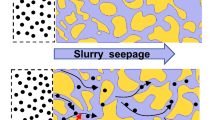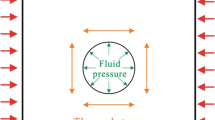Abstract
The potential for thermal convection in aquifers is strongly influenced by permeability. Permeability is highly heterogeneous within aquifers, and spatial distributions of permeability are rarely well constrained by measurements, making it difficult to determine the potential for thermal convection in a given aquifer. In this study, this difficulty is overcome through the use of a stratigraphic forward model (SFM). The SFM simulates the processes of deposition, burial and compaction of the aquifer, yielding a geologically plausible permeability field that is conditioned through measured permeability-porosity relationships. The aim of this study is to determine the influence of aquifer heterogeneity on the potential for thermal convection in the Yarragadee Aquifer, Western Australia. Permeability distributions from the SFM of the Yarragadee Aquifer are analysed through calculation of the thermal Rayleigh number (a stability criterion) from vertically averaged permeability, and numerical hydrothermal simulations with permeability distributions taken from the SFM. Results from the numerical simulations demonstrate that thermal convection can occur with the inclusion of geologically informed heterogeneity. These findings are supported by Rayleigh number calculations that indicate that convection is most likely to occur on the eastern side of the aquifer where it is thick and has high average permeability.
Résumé
Le potentiel de convection thermique en aquifères est fortement influencé par la perméabilité. La perméabilité est fortement hétérogène dans les aquifères, et des distributions spatiales de la perméabilité sont rarement bien contraintes par les mesures, rendant difficile de déterminer le potentiel de convection thermique dans un aquifère donné. Dans cette étude, cette difficulté est surmontée par l’utilisation d’un modèle stratigraphique direct (Startigraphic Forward Model - SFM). Le SFM simule les processus de dépôt, recouvrement et compaction de la formation aquifère, aboutissant à un champ de perméabilité géologiquement plausible qui est contraint par des rapports de perméabilité-porosité mesurés. Le but de cette étude est de déterminer l’influence de l’hétérogénéité de la couche aquifère sur le potentiel de convection thermique dans l’aquifère du Yarragadee en Australie occidentale. Les distributions de perméabilité du SFM de l’aquifère du Yarragadee sont analysées à travers le calcul du nombre thermique de Rayleigh (un critère de stabilité) à partir de la perméabilité moyenne calculée sur la verticale, et de simulations hydrothermales numériques avec des distributions de perméabilité prises du SFM. Les résultats des simulations numériques démontrent que la convection thermique peut se produire avec l’inclusion d’une hétérogénéité d’origine géologique. Ces résultats sont soutenus par les calculs du nombre de Rayleigh qui indiquent que la convection est plus susceptible de se produire du côté oriental de la couche aquifère où elle est épaisse et où la perméabilité moyenne est élevée.
Resumen
El potencial para la convección térmica en los acuíferos está fuertemente influenciado por la permeabilidad. La permeabilidad es altamente heterogénea dentro de los acuíferos, y las distribuciones espaciales de permeabilidad están raramente bien determinadas por mediciones, lo cual dificulta determinar el potencial para la convección térmico en un acuífero dado. En este estudio, esta dificultad es superada a través del uso de un modelo estratigráfico directo (SFM). El SFM simula los procesos de depositación, enterramiento y compactación del acuífero, brindando un campo de permeabilidad geológicamente verosímil que está condicionado a través de las medidas de las relaciones porosidad – permeabilidad. El objetivo de este estudio es determinar la influencia de la heterogeneidad del acuífero sobre el potencial de convección térmica en el Acuífero Yarragadee, Australia Occidental. Las distribuciones de permeabilidad del SFM del Acuífero Yarragadee son analizadas a través del cálculo de número térmico de Rayleigh (un criterio de estabilidad) proviniendo de la permeabilidad verticalmente promediada, y simulaciones numéricas hidrotermales con distribuciones de permeabilidad tomadas del SFM. Los resultados de las simulaciones numéricas demuestran que la convección térmica puede ocurrir con la inclusión de la heterogeneidad geológicamente documentada. Estos hallazgos están apoyado por el cálculo del número de Rayleigh que indican que la convección es más probable que ocurra en el lado este del acuífero donde es espeso y tiene una alta permeabilidad promedio.
摘要
摘要:含水层中的热自由对流潜力受渗透率的强烈影响。含水层内的渗透率非常不均匀,渗透率的空间分布很少和测量结果一致,这使得确定某一特定含水层的热对流潜力非常困难。在这项研究中,这个难题通过采用地层正演模型得到解决。地层正演模型模拟了含水层的沉积、埋藏和压实过程,产生了一个地质上似乎可信的渗透率场,这个渗透率场受到测量的渗透率-孔隙率关系的制约。本项研究的目的就是确定含水层非均质性对西澳大利亚州Yarragadee含水层中热对流潜力的影响。通过计算垂直上平均渗透率的热瑞利数(稳定性判据) 和利用从地层正演模型得到的渗透率分布数据进行数值热液模拟对Yarragadee含水层地层正演模型进行了分析。数值模拟结果显示,热对流可发生在地质上已知晓的非均质含水层中。这些发现得到了瑞利数计算结果的支持,表明对流最可能出现在含水层的东侧,那里含水层很厚,具有高度平均的渗透率。
Resumo
O potencial de convecção térmica em aquíferos é fortemente influenciado pela permeabilidade. A permeabilidade é altamente heterogénea no interior dos aquíferos, e distribuições espaciais da permeabilidade raramente são bem definidas através de medições, o que torna difícil determinar o potencial para a convecção térmica num determinado aquífero. Neste estudo, esta dificuldade é superada através da utilização de um modelo estratigráfico sequencial (MES). O MES simula os processos de deposição, enterramento e compactação do aquífero, produzindo um campo de permeabilidade geologicamente plausível que é condicionado através de relações permeabilidade-porosidade medidas. O objetivo deste estudo é determinar a influência da heterogeneidade aquífera sobre o potencial de convecção térmica no Aquífero Yarragadee, Austrália Ocidental. Distribuições da permeabilidade obtidas a partir do MES do Aquífero Yarragadee são analisadas através do cálculo do número térmico de Rayleigh (um critério de estabilidade) a partir da permeabilidade vertical média, e a partir de simulações numéricas hidrotermais com distribuições de permeabilidade retiradas do MES. Os resultados das simulações numéricas demonstram que a convecção térmica pode ocorrer com a inclusão da heterogeneidade geológica fornecida. Estes resultados são apoiados pelos cálculos do número de Rayleigh e indicam que a convecção é de ocorrência mais provável no lado oriental do aquífero, onde este é mais espesso e tem permeabilidade média elevada.








Similar content being viewed by others
References
Anderson MP, Woessner WW (1992) Applied groundwater modeling: simulation of flow and advective transport. Academic, Sydney
Corbel S, Schilling O, Horowitz FG, Reid LB, Sheldon HA, Timms NE, Wilkes P (2012a) Identification and geothermal influence of faults in the Perth metropolitan area. Thirty-Seventh Workshop on Geothermal Reservoir Engineering, Stanford, CA, 30 January–1 February 2012
Corbel S, Griffiths C, Dyt C (2012b) Hot sedimentary aquifer characterization using forward modelling, Perth Basin, Australia. Thirty-Seventh Workshop on Geothermal Reservoir Engineering, Stanford, CA, 30 January–1 February 2012
Crostella A, Backhouse J (2000) Geology and petroleum exploration of the central and southern Perth Basin, Western Australia. Western Australia Geological Survey Report 57, GSWA, Perth, Australia, 85 pp
CSIRO (2007) PressurePlot. CSIRO, Perth, Australia. www.pressureplot.com. Accessed 21 Dec 2012
Davidson WA (1995) Hydrogeology and groundwater resources of the Perth region, Western Australia. Geological Survey of Western Australia Bulletin 142, GSWA, Perth, Australia, 270 pp
Diersch H-JG, Kolditz O (2002) Variable-density flow and transport in porous media: approaches and challenges. Adv Water Resour 25:899–944
Domenico PA, Schwartz FW (1998) Physical and chemical hydrogeology Wiley, New York
Epherre JS (1975) Criterion for the appearance of natural convection in an anisotropic porous layer. Int J Chem Eng 17:615–616
Griffiths C, Dyt C, Paraschivoiu E, Liu K (2001) Sedsim in hydrocarbon exploration. In: Merriam D, Davis J (eds) Geologic modelling and simulation. Kluwer, New York
Hot Dry Rocks Pty Ltd (2008) Geothermal energy potential in selected areas of Western Australia (Perth Basin). Hot Dry Rocks, Melbourne, Australia, 270 pp
Kühn M, Dobert F, Gessner K (2006) Numerical investigation of the effect of heterogeneous permeability distributions on free convection in the hydrothermal system at Mount Isa, Australia. Earth Planet Sci Lett 244:655–671. doi:10.1016/j.epsl.2006.02.041
Magri F (2009) Derivation of the coefficients of thermal expansion and compressibility for the use in FEFLOW finite element subsurface flow and transport simulation system. White Papers, vol 3, WASY, Berlin, pp 13–24
McKibbin R, O’Sullivan MJ (1980) Onset of convection in a layered porous-medium heated from below. J Fluid Mech 96:375–393. doi:10.1017/s0022112080002170
McKibbin R, Tyvand PA (1983) Thermal-convection in a porous-medium composed of alternating thick and thin layers. Int J Heat Mass Transf 26:761–780. doi:10.1016/0017-9310(83)90027-3
Mory AJ, Iasky RP (1996) Stratigraphy and structure of the onshore northern Perth Basin, Western Australia. Western Australia Geological Survey Report 46, GSWA, Perth, 126 pp
Philips OM (1991) Flow and reactions in permeable rocks. Cambridge University Press, Cambridge
Playford PE, Cockbain AE, Low GH (1976) Geology of the Perth Basin. Geological Society of Western Australia Bulletin, GSWA, Perth, 124 pp
Prasad A, Simmons CT (2003) Unstable density-driven flow in heterogeneous porous media: a stochastic study of the Elder 1967b “short heater” problem. Water Resour Res 39(1), 1007. doi:10.1029/2002wr001290
Reid LB, Bloomfield G, Ricard LP, Botman C, Wilkes P (2012) Shallow geothermal regime in the Perth metropolitan area. Aust J Earth Sci 59:1033–1048. doi:10.1080/08120099.2012.692711
Schilling O, Sheldon HA, Reid LB, Corbel S (2013) Hydrothermal models of the Perth Metropolitan Area Western Australia: implications for geothermal energy. Hydrogeol J. doi:10.1007/s10040-012-0945-0
Sharp JM, Shi M (2009) Heterogeneity effects on possible salinity-driven free convection in low-permeability strata. Geofluids 9:263–274. doi:10.1111/j.1468-8123.2009.00262.x
Sheldon HA, Florio B, Trefry MG, Reid LB, Ricard LP, Ghori KAR (2012) The potential for convection and implications for geothermal energy in the Perth Basin, Western Australia. Hydrogeol J 20:1251–1268. doi:10.1007/s10040-012-0886-7
Simmons CT (2005) Variable density groundwater flow: from current challenges to future possibilities. Hydrogeol J 13:116–119. doi:10.1007/s10040-004-0408-3
Simmons CT, Fenstemaker TR, Sharp JM (2001) Variable-density groundwater flow and solute transport in heterogeneous porous media: approaches, resolutions and future challenges. J Contam Hydrol 52:245–275. doi:10.1016/s0169-7722(01)00160-7
Simmons CT, Kuznetsov AV, Nield DA (2010) Effect of strong heterogeneity on the onset of convection in a porous medium: importance of spatial dimensionality and geologic controls. Water Resour Res 46, W09539. doi:10.1029/2009wr008606
Tetzlaff DM, Harbaugh JW (1989) Simulating clastic sedimentation. Computer Methods in the Geosciences series. Reinhold, New York
Timms NE, Corbel S, Olierook H, Wilkes PG, Delle Piane C, Sheldon HA, Alix R, Horowitz FG, Wilson MEJ, Evans KA, Griffiths C, Stütenbecker L, Israni S, Hamilton PJ, Esteban L, Cope P, Evans C, Pimienta L, Dyt C, Huang X, Hopkins J, Champion D (2012) Perth Basin Assessment Program project 2: geomodel. Western Australian Geothermal Centre of Excellence, Perth, Australia
Wagner W, Cooper JR, Dittmann A, Kijima J, Kretzschmar HJ, Kruse A, Mares R, Oguchi K, Sato H, Stocker I, Sifner O, Takaishi Y, Tanishita I, Trubenbach J, Willkommen T (2000) The IAPWS industrial formulation 1997 for the thermodynamic properties of water and steam. J Eng Gas Turbines Power 122:150–182. doi:10.1115/1.483186
Weatherill D, Simmons CT, Voss CI, Robinson NI (2004) Testing density-dependent groundwater models: two-dimensional steady state unstable convection in infinite and finite inclined porous layers. Adv Water Resour. doi:10.1016/j.advwatres.2004.01.003, 27
Acknowledgements
This work was supported by: (1) the Western Australian Geothermal Centre of Excellence (WAGCOE), a joint initiative between the Commonwealth Scientific and Industrial Research Organisation (CSIRO), the University of Western Australia and Curtin University, and (2) the National Centre for Groundwater Research and Training (NCGRT) through the Australian Research Council and the National Water Commission. We would like to thank Thomas Poulet and Luk Peeters who reviewed an early version of this manuscript, as well as Joseph Hughes, Robert Maliva, Lynn Reid and one anonymous reviewer for their reviews which helped improve the paper.
Author information
Authors and Affiliations
Corresponding author
Appendix
Appendix
Conversion from permeability to hydraulic conductivity
Much of the discussion in this paper is focused on permeability (k; m2), which is related to hydraulic conductivity (K, m s−1) by the expression K = kρg/μ, where ρ and μ are fluid density and viscosity. For hydrothermal simulations which include variable density and viscosity, FEFLOW requires K to be entered at a reference temperature. The Beta-Gamma plug-in (Magri 2009) allows the thermal expansion term to vary with temperature, and requires that the reference temperature be set to 0 °C. At 0 °C and 1 bar, the reference density ρ 0 is 999.84 kg/m3 and reference viscosity μ 0 is 0.001792 Pa s (Wagner et al. 2000). Thus the multiplying factor from k to K is ρ 0 g/μ 0 = 5,474,907 m−1 s−1.
Rights and permissions
About this article
Cite this article
Irvine, D.J., Sheldon, H.A., Simmons, C.T. et al. Investigating the influence of aquifer heterogeneity on the potential for thermal free convection in the Yarragadee Aquifer, Western Australia. Hydrogeol J 23, 161–173 (2015). https://doi.org/10.1007/s10040-014-1194-1
Received:
Accepted:
Published:
Issue Date:
DOI: https://doi.org/10.1007/s10040-014-1194-1




